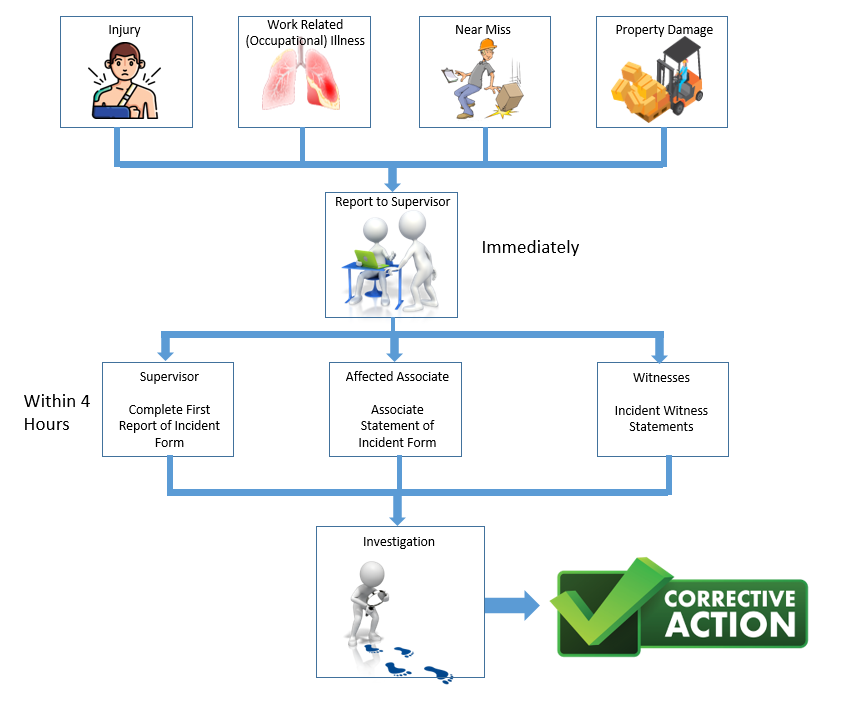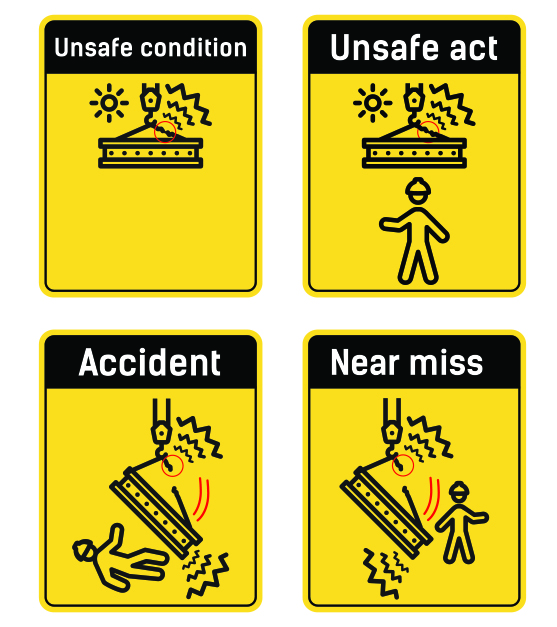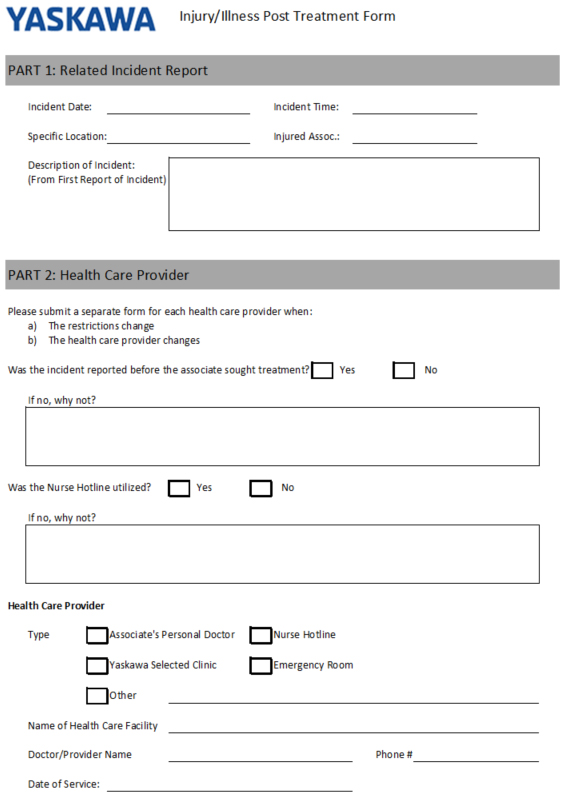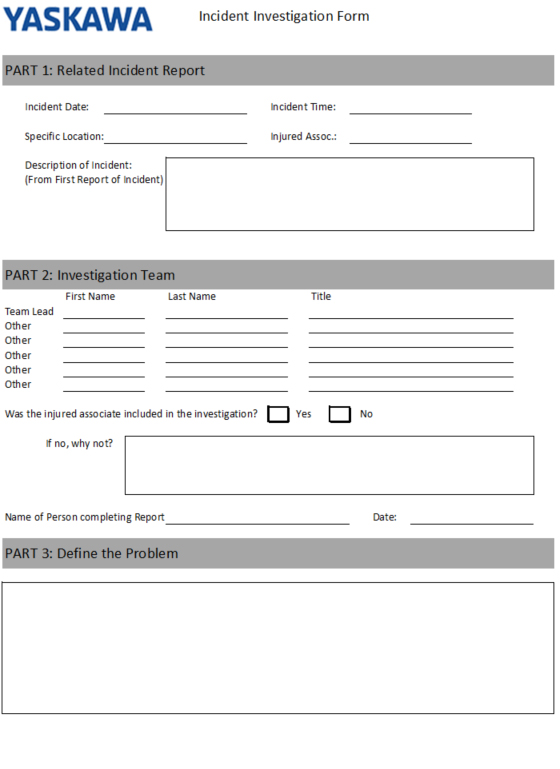Policy Key Points

- An accident is an unintended event in which a person is injured, experiences an occupational illness, or in which property damage occurs.
- A near-miss (sometimes called near-hit) is an unplanned event that did not result in an injury, occupational illness, or property damage but had the potential to do so. Only a fortunate break in the chain of events prevented an injury, fatality, illness, or damage.
- All incidents must be immediately reported to the affected associate's supervisor or another member of management.
- The associate's supervisor must complete the First Report of Incident form and submit it to HR and EHS within 4 hours of being notified of the incident.
- The affected associate must complete the Associates Statement of Incident as soon as they are medically able (The first priority is to get injured or ill associates the medical attention they need)
- Witnesses of the incident must complete the Incident Witness Statement.
- Light Duty shall be accomodated unless doing so poses a safety risk to the associate or others.
- All incidents are investigated. The nature and thoroughness of the investigation is dependent on the severity of what could have happened - not necessarily of what did happen.
- For instance, a near-miss that had the potential for a fatality but in which no person was injured is more severe than an actual incident where there was not the potential for severe injury.
Policy
Incident Reporting
Types of Incidents that Require a First Report of Incident Form
- Any injury or occupational illness, regardless of the severity
- Any Incident of property damage of:
- Powered Industrial Vehicles (forklifts, order pickers, powered pallet jacks, man-lifts)
- Lifting Equipment (cranes, hoists, rigging, Bishimon lifts, Big Joe's)
- Electrical Test Equipment
- Machinery
- Structural Components of the facility
- Structural Components of Warehouse Racking
- Any property damage in excess of $100 (excluding quality defects for which Nonconforming Material tag is used)
- Any Near Miss
- A near miss is an unplanned event that did not result in injury, occupational illness, or damage, but had the potential to do so. Only a fortunate break in the chain of events prevented an injury, fatality, illness, or damage.
- NOTE: An unsafe condition or observation of unsafe behavior must be reported but, by definition, an unsafe condition or observation of unsafe behavior by themselves do not constitute a near-miss.
- The following observations must be immediately corrected and reported to management. A First Report of Incident form must be submitted for these observations:
- Unsafe act on or around a powered industrial vehicle
- Unsafe act around electrical power
- Unsafe act on or around machinery (eg: removing a machine guard)
Light Duty Program
Yaskawa America, Inc. is committed to supporting the recovery and well-being of associates who experience work-related injuries or illnesses. As part of our Incident Reporting and Injury Management process, the Light Duty Program is designed to facilitate the timely and safe return of injured employees to the workplace.
Light duty assignments will be provided to associates with temporary work restrictions, unless doing so would pose a safety hazard to the associate or others. These assignments may involve modifying existing duties or temporarily reassigning the associate to tasks that align with their current capabilities as defined by a medical professional. Denying light duty must be approved by the VP of Human Resources, the VP of Operations, or the Director of Human Resources.
Benefits of the Light Duty Program
- Promotes recovery and engagement: Remaining active in the workplace supports physical and psychological recovery by keeping associates connected to their work environment. Workers who attempt to recuperate at home often have longer recovery times and additional health complications.
- Reduces time away from work: Light duty helps minimize lost workdays, supporting operational continuity and employee productivity.
- Improves communication: Continued workplace presence encourages better communication between the associate, their supervisor, and EHS/HR representatives.
- Maintains team morale: Employees on light duty remain part of the team, reinforcing a culture of care, accountability, and support.
Yaskawa America require all departments to make reasonable efforts to accommodate light duty whenever medically appropriate and safe. The EHS and HR teams will work closely with supervisors and healthcare providers to ensure appropriate placement and oversight of light duty assignments.
Incident Investigation
Each incident that requires a First Report of Incident form must also be investigated. The scale and scope of the investigation shall be appropriate to the consequences and potential consequences of the incident.
Investigations shall include examining factors related to the process, the people, material, equipment, environment and management.

The affected associate's immediate supervisor is responsible for completing the First Report of Incident. When the affected associate's immediate supervisor is not available, the First Report of Incident shall be completed by another member of management.
When the form is submitted, a link to the form is sent to Human Resources, EHS, and the affected associate's immediate supervisor.
Incident Corrective Action
After reviewing the First Report of Incident form, and possibly the preliminary investigation report submitted by the area supervisor, the EHS Department or other member of management, may determine that more thorough corrective action is appropriate.
Formal corrective action is required for all incidents, including near misses, that had the potential to result in a Serious Injury or Fatality (SIF).
Incident Corrective Action is a more thorough investigation that involves using an 8-D (eight disciplines) approach. The 8 disciplines are:
- Identify the Problem
- Select the Team
- Implement Containment Action
- Complete Root Cause Analysis
- Using disciplined methods such as Ishikawa Diagrams (Fishbone), 5-Why, and Fault Tree Analysis (preferred)
- Identify Corrective Action
- Implement Corrective Action
- Verify Corrective Action
- Verify Long Term Sustainability (Long-term verification, such as audits)
Records Related to this Policy
| Record |
Retained by |
Retention Time |
| First Report of Incident and related documents involving an injury or occupational illness |
Human Resources |
Tenure of employment plus 5-years (30-years for cases involving occupational exposure to hazardous materials) |
| First Report of Incident and related documents involving property damage |
Facilities |
Maintained a minimum of 5-years or equipment life (whichever is longer) |
| First Report of Incident and related documents involving a near miss |
EHS Department |
5-years (min) |
| Corrective Action Reports |
EHS Department |
5-years (min) |
Revision History
| Rev # |
Description |
Release Date |
Approved by |
| 0 |
Conversion of old safety documents, rewrite, and issue |
4/12/2016 |
Thurwanger |
| 1 |
Updated form numbers for Associate and Witness statements |
8/24/2017 |
Thurwanger |
| 2 |
Updated email link to workcomp@yaskawa.com |
2/19/2024 |
Thurwanger |
|
|
|
|
|
|
|
|
|
|
|
|
Program Review
| Review Date |
Reviewed by |
Changes Required (Yes/No) |
Revision # if updated |
| 2/21/2017 |
Thurwanger |
No |
|
| 1/16/2018 |
Thurwanger |
No |
|
| 1/22/2019 |
Thurwanger |
No |
|
| 1/14/2020 |
Thurwanger |
No |
|
| 1/21/2021 |
Thurwanger |
No |
|
| 1/18/2022 |
Thurwanger |
No |
|
| 1/31/2023 |
Thurwanger |
No |
|
| 1/16/2024 |
Thurwanger |
Yes |
2 |
| 1/21/2025 |
Thurwanger |
No |
|
|
|
|
|





